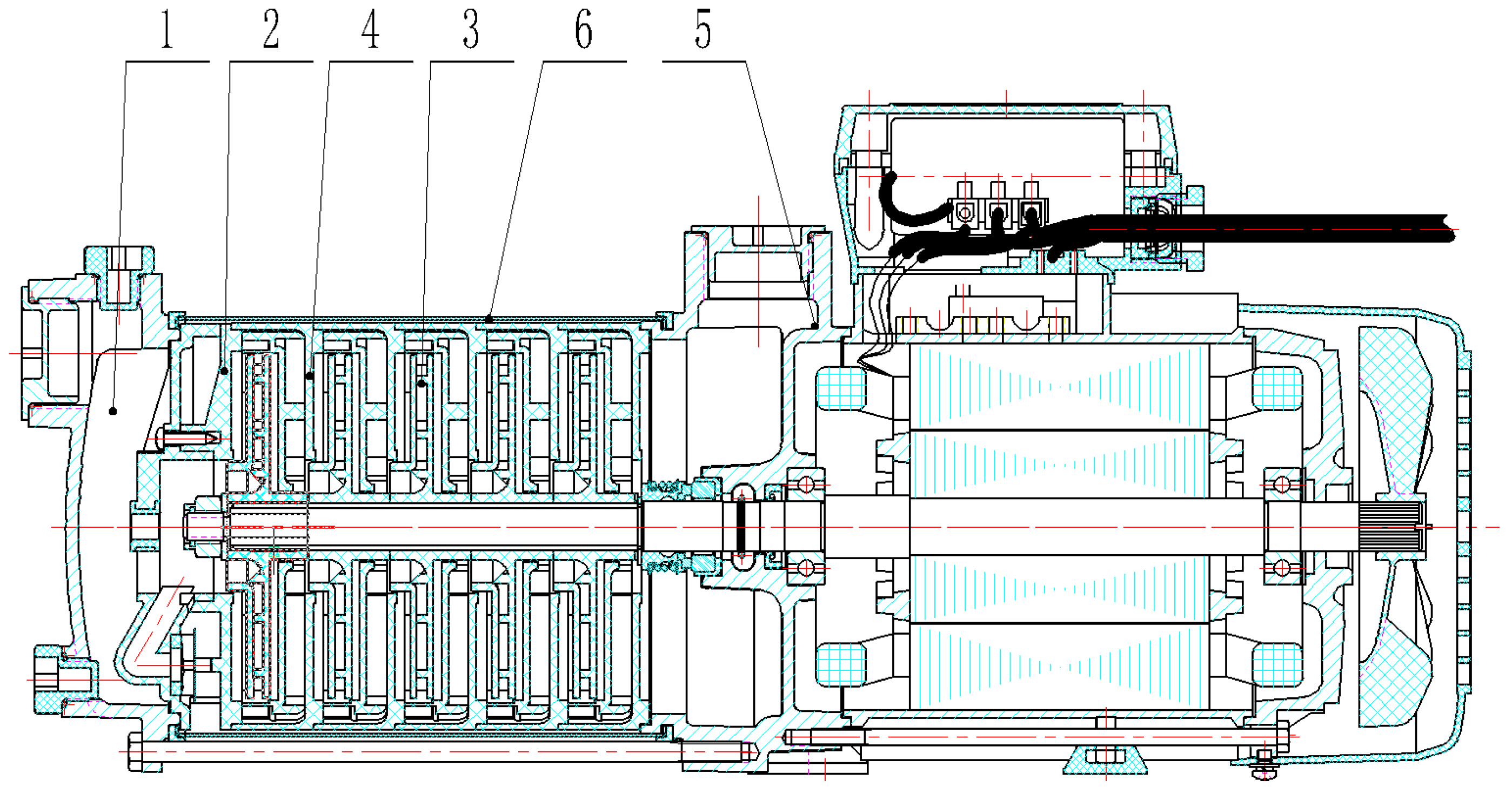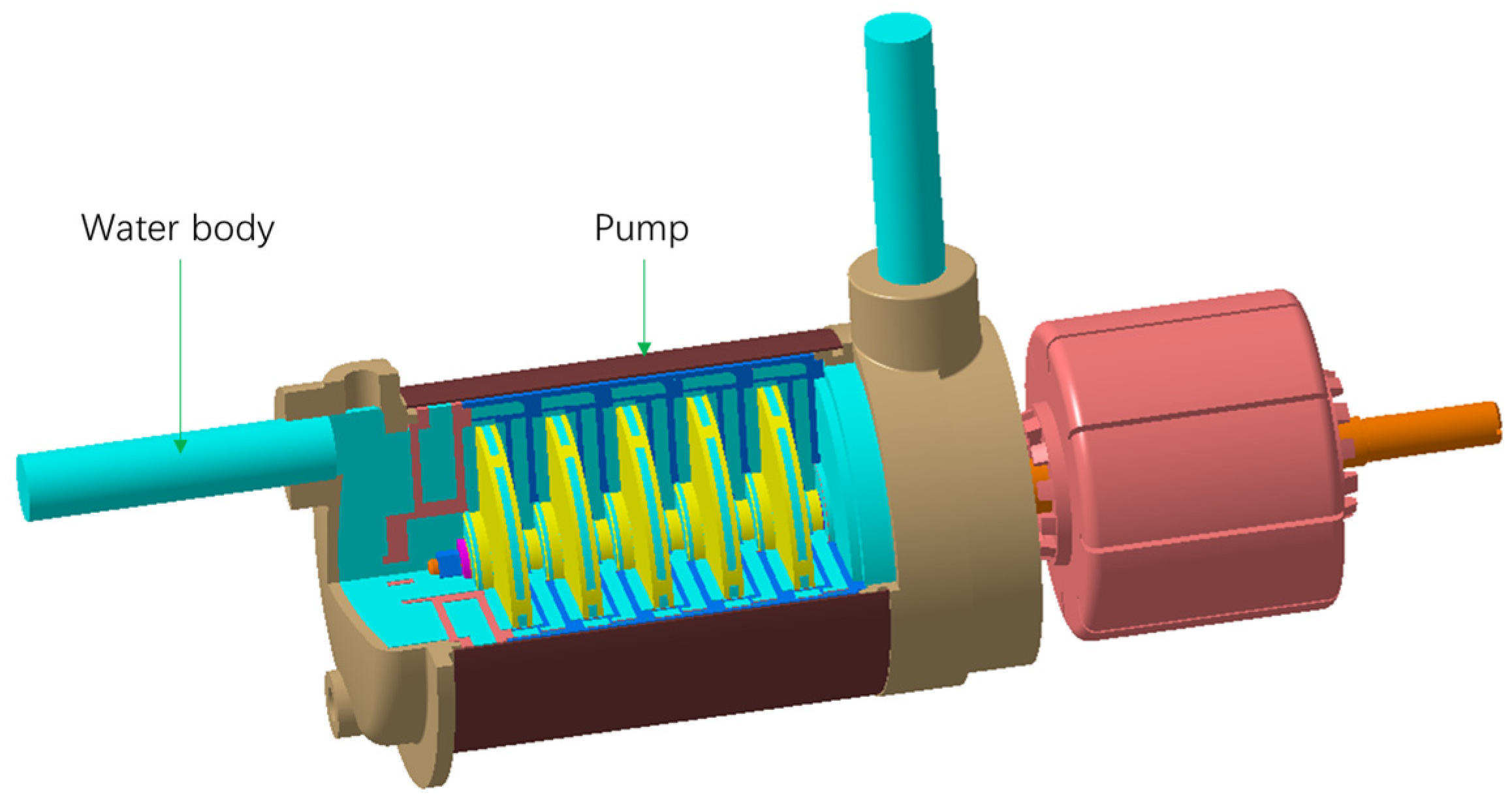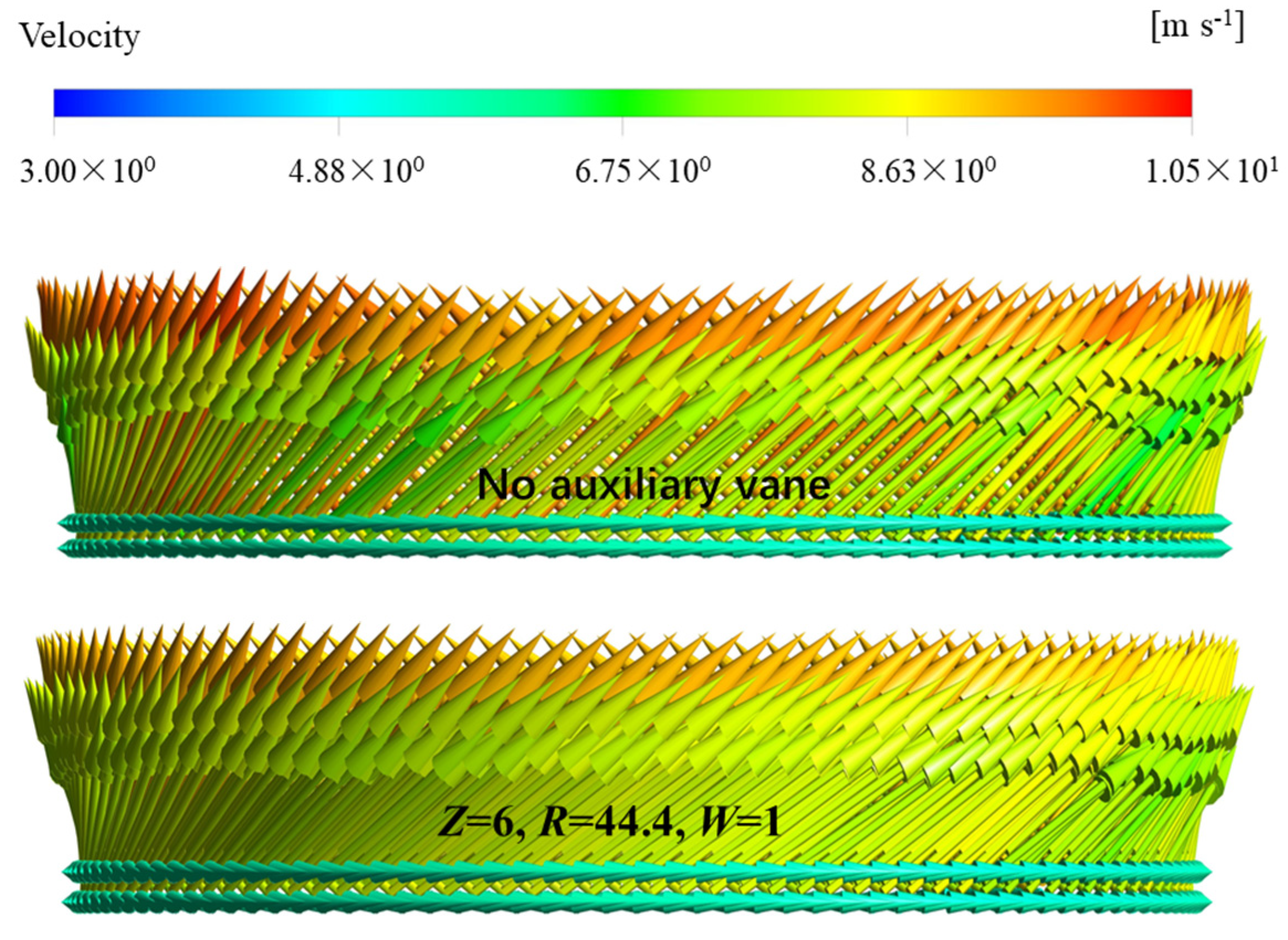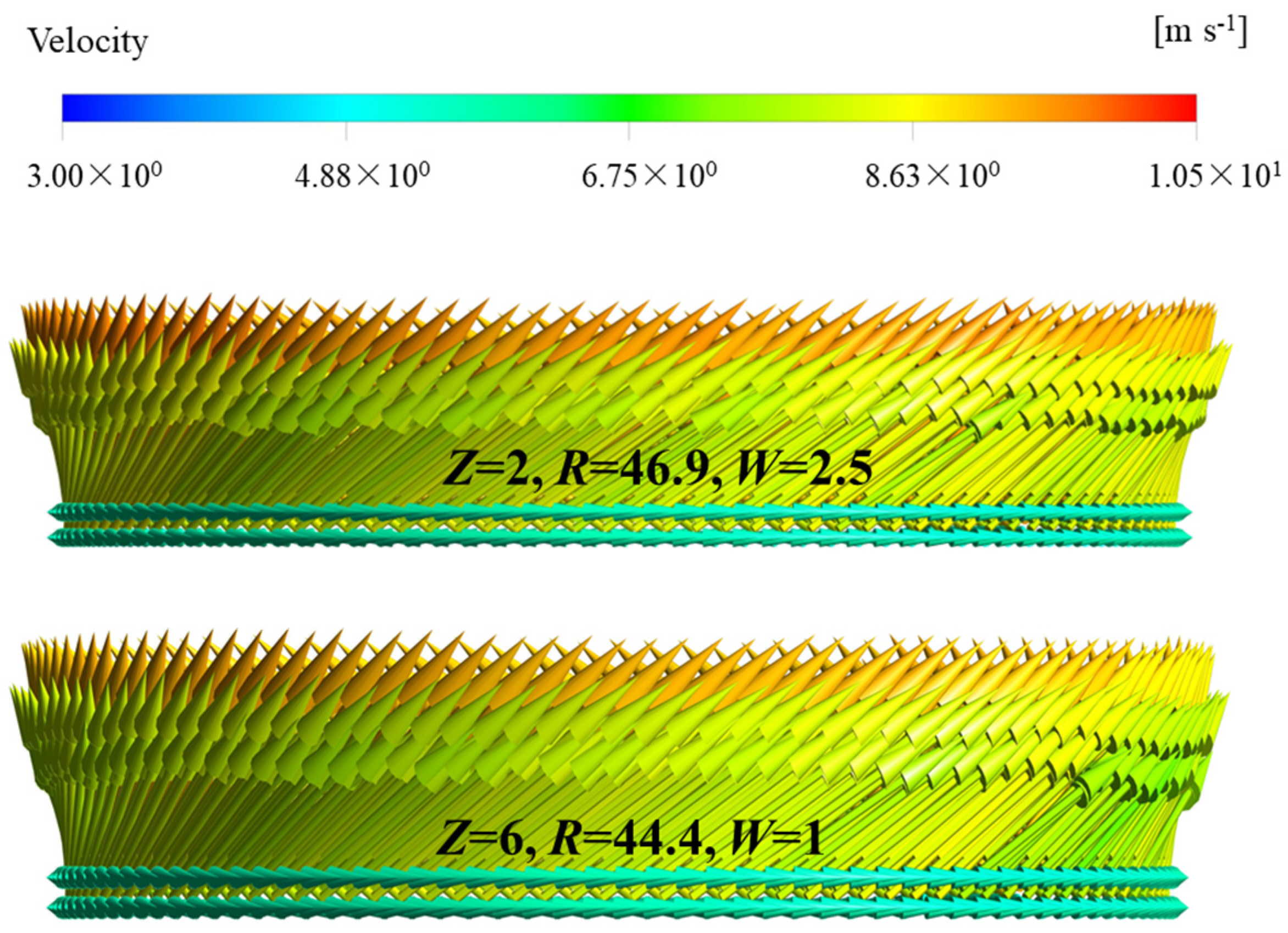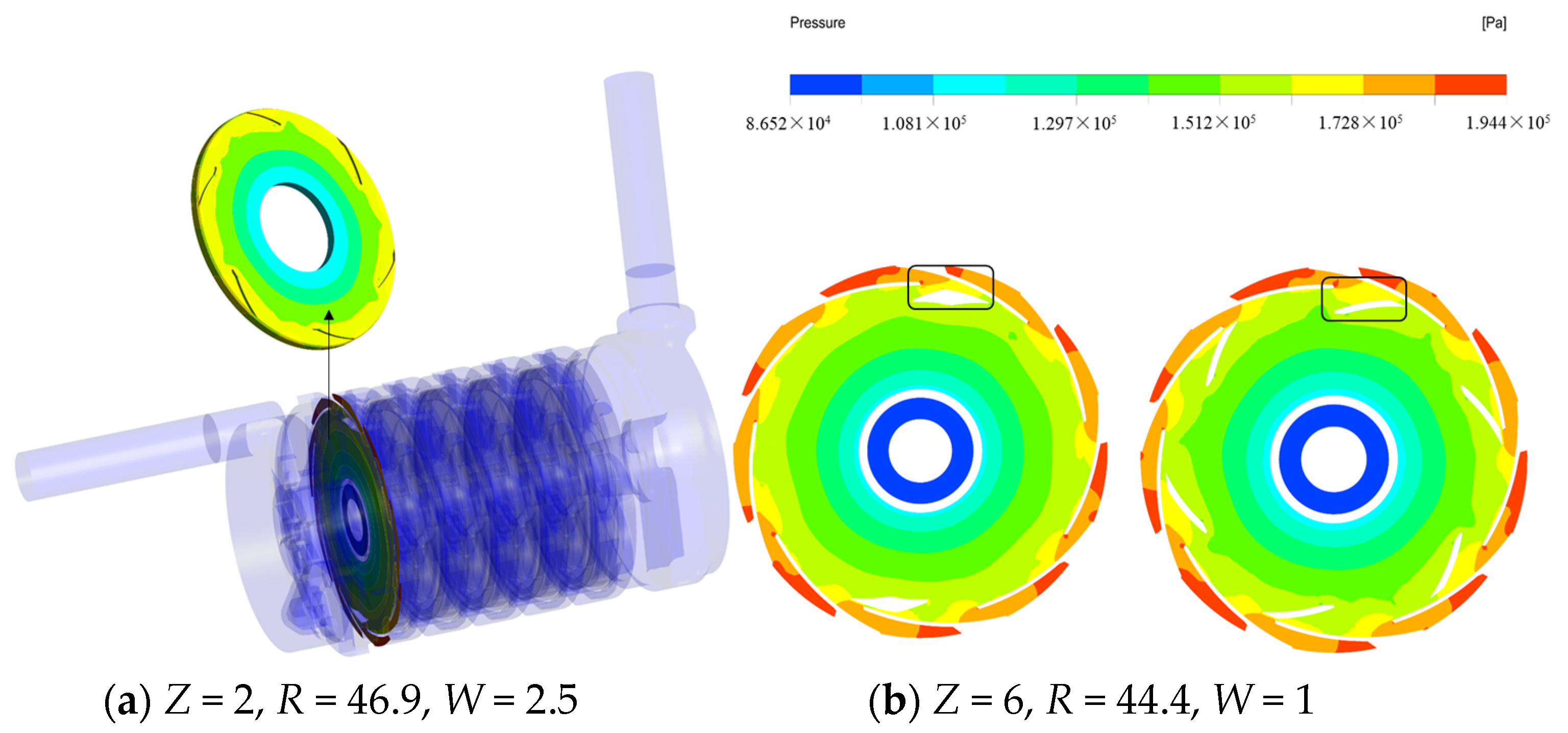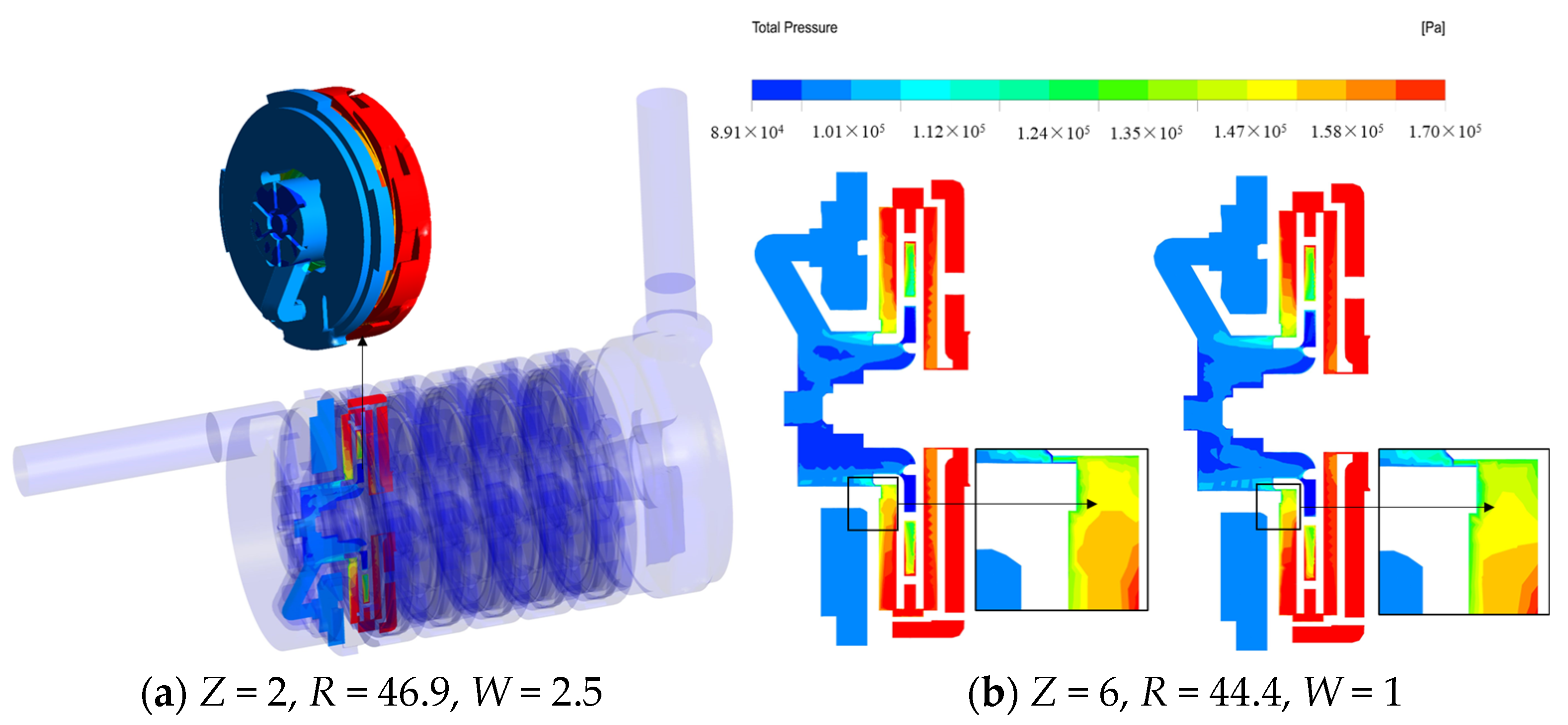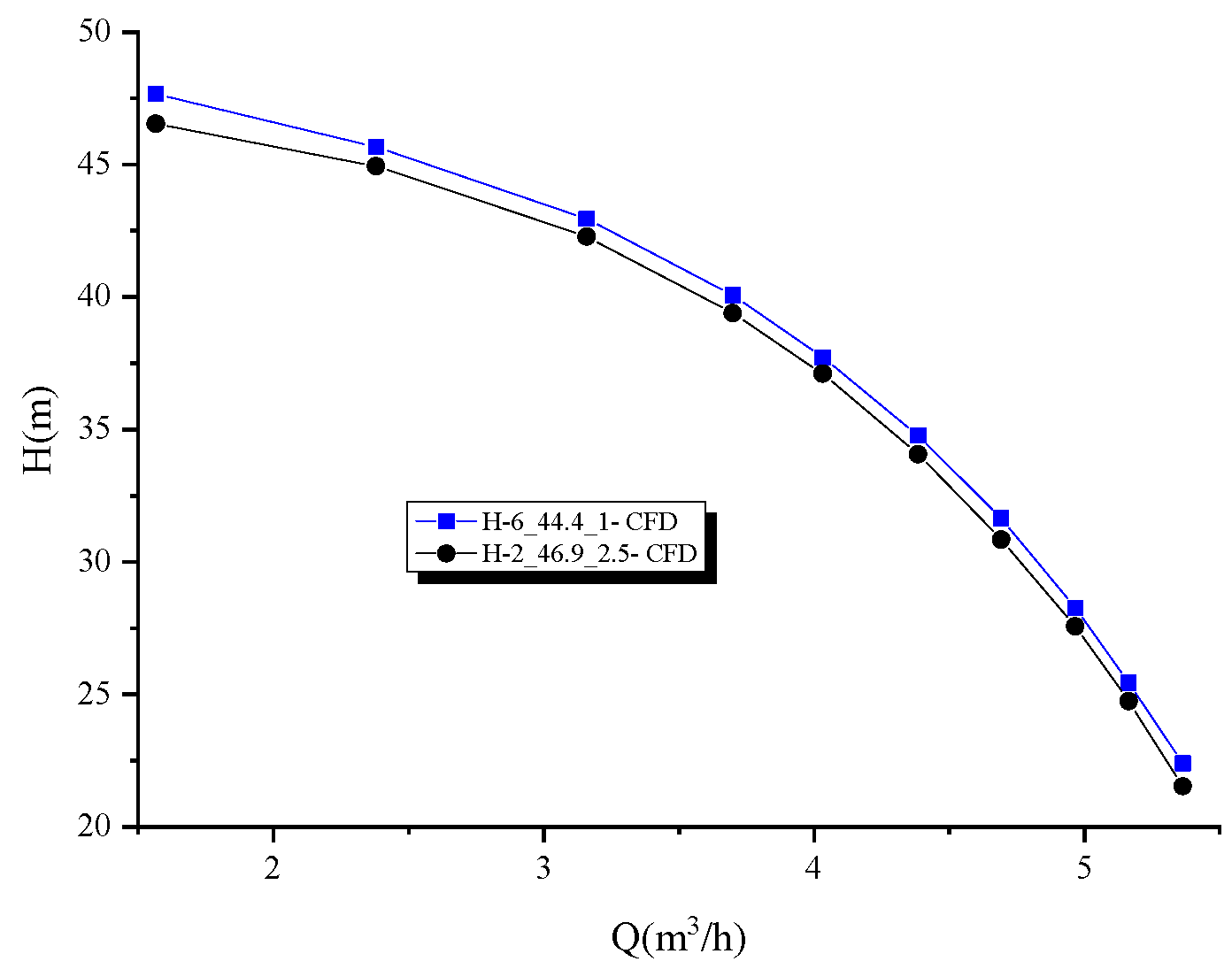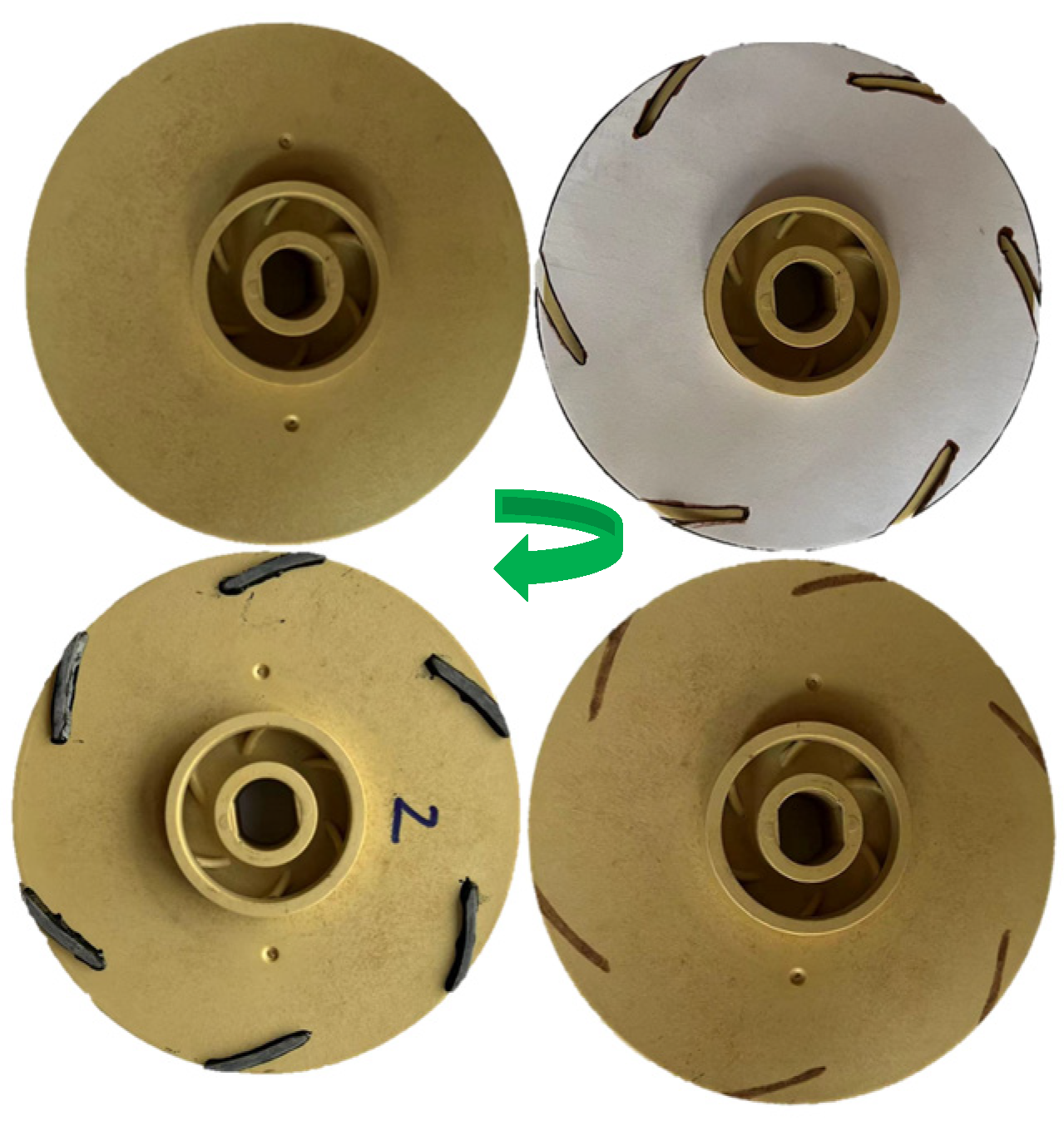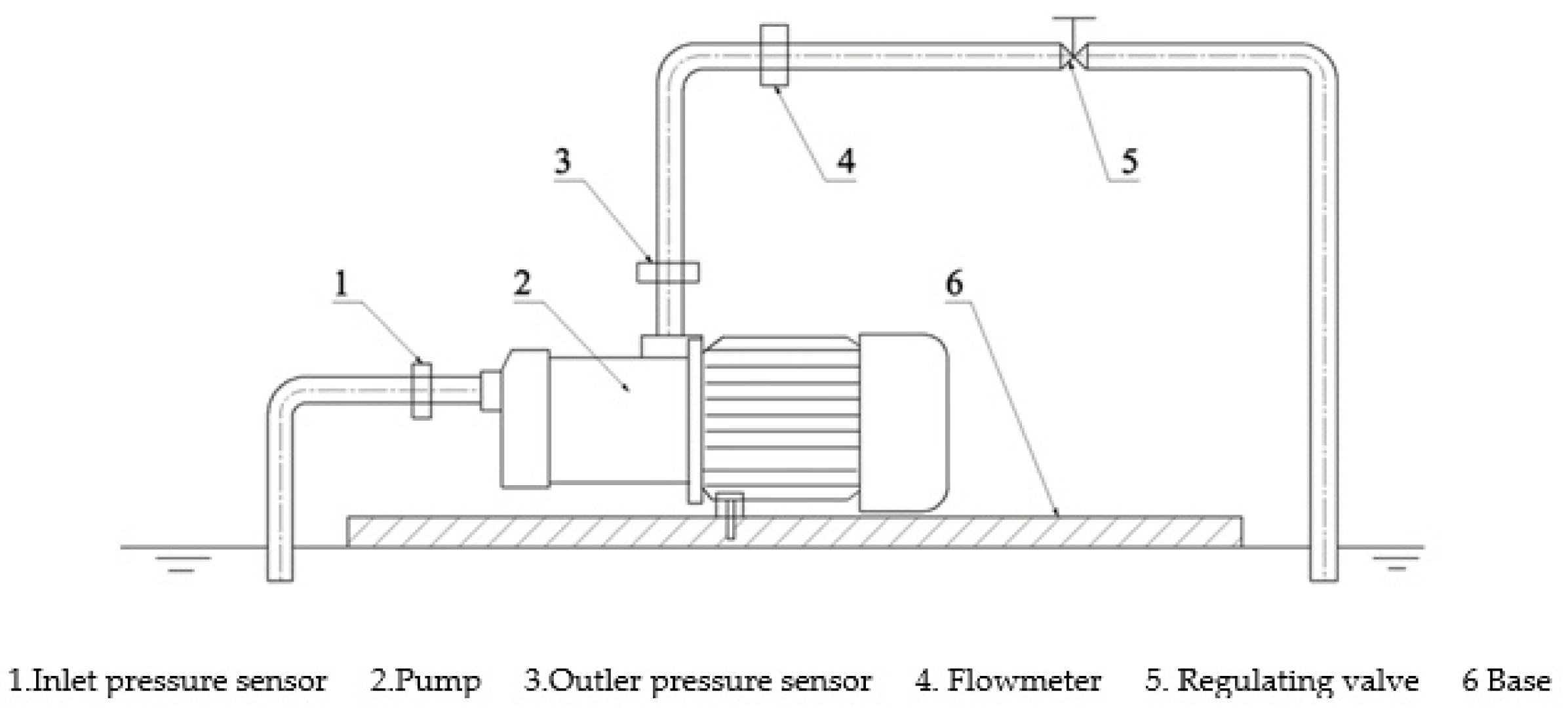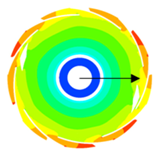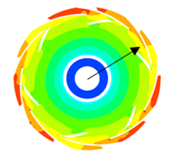1. Introduction
The design methods of orthogonal experiments and grey relational analysis are efficient, rapid, and economical. When the number of experiments required is too large, some representative levels can be selected, to reduce the workload of the experiments [
1]. In recent years, scholars have improved the development efficiency by carrying out experimental analysis in the field of pumps, based on orthogonal experiments and grey relational analysis methods. Chang Hao et al. [
2] used orthogonal design methods to study jet self-priming centrifugal pumps, designed nine different nozzle structures, conducted self-priming experiments, and obtained the influence of nozzle geometric parameters on self-priming performance through grey relational analysis. By adjusting the geometric parameters of the nozzle, the self-priming performance was significantly improved. YangYang et al. [
3] optimized the structure of the drainage trough of a typical low-specific-speed centrifugal pump based on a combination of orthogonal experiments and numerical simulations. They determined the priority of various geometric factors of the drainage trough for pump performance and obtained the best impeller drainage trough scheme. Hui Quan et al. [
4] used orthogonal experiments combining experimental testing and numerical calculations to optimize the design structure of a vortex pump impeller, to study the impact of different types of impellers on the performance of the vortex pump, and they derived the primary and secondary influences on the performance of the vortex pump. The optimal combination scheme was 36% higher than the design value under the rated flow head, and the efficiency was 18.75% higher than the design value, making the high-efficiency area of the vortex pump wider. Wang Yuqin et al. [
5] optimized the structural parameters of a low-specific-speed centrifugal pump based on orthogonal experiments, to eliminate the hump phenomenon. They obtained the influence weights of the selected factors on the experimental results, and selected the best scheme, according to the weights. By optimizing the structural parameters of the pump, the hydraulic loss of its jet wave was reduced, and the hump phenomenon of the head curve was effectively eliminated. The performance indicators of the optimized pump were higher than those of the prototype pump, verifying the accuracy and reliability of the orthogonal experiment. Pei Ji et al. [
6] studied the optimization of pump cavitation performance based on orthogonal experiments and selected the impeller inlet diameter, inlet attack angle, and blade wrap angle as factors; and their experimental verification showed that the selection of impeller inlet diameter had the greatest impact on the pump cavitation performance, while the optimized impeller provided better flow conditions. Wang Chuan [
7] combined orthogonal experiments and grey relational analysis methods to study the self-priming performance of low-specific-speed centrifugal pumps; selected the blade outlet width, radial gap between the impeller and guide vane, return hole area, and the number of stages of the multistage centrifugal pumps as experimental factors; conducted an orthogonal experimental analysis of the self-priming performance of multistage centrifugal pumps; obtained the optimal solution; and utilized grey relational analysis methods to derive the primary and secondary factors affecting pump self-priming performance. Other scholars have also conducted research in related fields with pumps using orthogonal experiments and grey relational analysis methods [
8,
9,
10,
11].
The above literature mainly focused on the structural optimization and pump performance improvement based on orthogonal experiments and grey relational analysis methods, and it did not involve how to change the geometric parameters of auxiliary blades of multistage centrifugal pump impellers to improve the pump head. This article takes a five-stage centrifugal pump as the research object, based on orthogonal experiments and grey relational analysis methods, selects auxiliary blades with different structural parameters for analysis, aims to improve the pump head, and obtains the optimal auxiliary blade impeller structure and the primary and secondary factors affecting the head.
8. Optimal Solution and Optimized Scheme Simulation Analysis
Based on the above analysis, the optimal solution for the pump head is A3B1C1, with the following parameters: auxiliary blade quantity (Z) = 6, auxiliary blade inner diameter (R) = 44.4 mm, and auxiliary blade width (W) = 1. To simulate and calculate this data, a similar method to as mentioned previously was used for grid partitioning and computational modeling. After the calculations, under the operating condition of flow rate Q = 3.5 m3/h, the pump head was determined to be 41.39 m, the hydraulic efficiency was 37.98%, and the pump’s gland leakage rate was 1.36 kg/s.
Figure 10 presents a comparative analysis of the flow field in the impeller front chamber for both the optimized and optimal solution schemes. Near the auxiliary blades, the fluid moves outward due to centrifugal force. Since the optimized solution has fewer and smaller auxiliary blades, there are significant areas without auxiliary blades. In these regions, the fluid velocity changes due to the guiding effect of the volute casing, and some of the fluid flows towards the center of the impeller. Subsequently, leakage flow occurs along the throat region, resulting in relatively significant volumetric losses. The optimal solution has six auxiliary blades, with larger radial and circumferential dimensions compared to the optimized solution. This allows it to generate centrifugal force on a larger volume of fluid. On the other hand, the optimized solution only has two auxiliary blades, and their radial dimensions are relatively smaller, resulting in a lower ability to prevent backflow compared to the optimal solution. The optimal solution exhibits lower leakage flow and relatively smaller volumetric losses, resulting in higher head for the same flow rate.
Figure 11 shows a comparison of the throat ring flow velocity vectors between the optimized scheme and the optimal solution scheme. It can be seen that the flow velocity color of the impeller in the optimized scheme is close to red, which is higher than the flow velocity of the impeller in the optimal solution scheme, resulting in a larger annular leakage volume per unit time. Intuitively, the impeller of the optimal solution scheme has a lower volumetric loss compared to the impeller of the optimized scheme. This is because, in the region between the volute casing and the impeller, where the leakage occurs, the optimal solution has a larger number of auxiliary blades, creating more high-pressure areas. This effectively reduces leakage at that location, resulting in lower velocities at the throat region.
Figure 12 depicts a comparison of the pressure contour plots in the front chamber region between the optimized solution and the optimal solution. From the figure, it is evident that the presence of the auxiliary blades creates a high-pressure zone in the working surface. Therefore, in the vicinity of the high-pressure zone, the flow velocity decreases, which serves as a source of volute leakage. Consequently, the volumetric leakage rate per unit time decreases, resulting in a higher pump head. The optimized solution exhibits fewer high-pressure zones compared to the optimal solution, leading to a relatively higher volumetric leakage rate in the optimized solution. Additionally, the optimal solution features auxiliary blades with larger radial and circumferential dimensions, creating more high-pressure zones. This further emphasizes that the optimal solution can achieve smaller volumetric losses. Under the influence of the auxiliary blades, the water in the front chamber is subjected to centrifugal forces, causing it to flow outward and reducing the pressure in the front chamber. A low-pressure zone is formed near the center of the impeller, exhibiting a symmetrical distribution along the circumference. From the comparison plot, it can be observed that the low-pressure zone area in the optimal solution is larger than that in the optimized solution. The axial force in the rotor system primarily originates from the pressure difference between the front and rear sides of the impeller. Typically, the pressure on the outer side of the back cover plate is higher than that on the outer side of the front cover plate. Therefore, as the pressure on the outer side of the front cover plate decreases, the corresponding axial force increases. This indicates that the optimal solution generates a greater axial force when the impeller is in operation. Through calculations, it was determined that the pump bearings could withstand the increased axial force associated with the optimal solution.
The leakage through the throat ring is an important component of volumetric losses. The calculation formula for volumetric losses at the throat ring is given by Equation (11) [
30].
where
Qs is the leakage rate of the throat ring,
Acl represents the cross-sectional area of the throat ring, Δ
Hcl is the difference in head on both sides of the throat ring,
μ is the leakage coefficient, and
g is gravitational acceleration.
Figure 13 presents a comparison of the total pressure on both sides of the throat ring between the optimized design and the optimal solution for the first-stage impeller. From the figure, it can be observed that the pressure difference across the throat ring is smaller for the optimal solution compared to the optimized design. According to Equation (11), when the difference in head between the two sides of the throat region is small, this corresponds to a lower leakage rate at the throat. This is because in the optimal solution, the difference in head between the two sides of the throat region is relatively small. It can be inferred that the leakage rate at the throat ring is lower for the optimal solution, resulting in relatively smaller volumetric losses. Under unchanged conditions, at the same flow rate, the optimal solution pump achieves a higher head.
Figure 14 shows a comparison of the turbulence kinetic energy contour maps of the water section in the pre-cavity of the impeller between the optimized scheme and the optimal solution scheme. As can be seen from the figure, the turbulence kinetic energy values in the inner region of the water body in the pre-cavity of the impeller of the optimized scheme are relatively low, with the values gradually increasing from the inside to the outside. From the lowest blue area outward, the turbulence kinetic energy exhibits irregularly alternating high and low changes. The turbulence kinetic energy is significantly increased on the inner side of the auxiliary blades, resulting in higher energy losses. Similarly, the inner side of the water body in the pre-cavity of the optimal solution scheme also has lower turbulence kinetic energy values, with the values gradually increasing from the inside to the outside. Near the auxiliary blades, the turbulence kinetic energy changes are relatively stable, resulting in less energy being lost. In the outermost region of the pre-cavity water body, the area where the dynamic water body of the auxiliary blades interacts with the static water body of the guide vanes causes a significant increase in turbulence kinetic energy, resulting in higher turbulent energy losses. By comparing the two schemes, it can be seen that the turbulence kinetic energy of the pre-cavity water body in the optimized scheme is significantly higher than that of the optimal solution scheme, indicating that the turbulent energy loss in the pre-cavity water body of the optimal solution is lower.
Based on the above simulation analysis, transient simulations were performed for both the optimized scheme and the optimal solution scheme. Pressure measurements were taken at the center of the pump inlet and outlet, with every 4° rotation of the impeller as a time step. The pressure fluctuations at each monitoring point were calculated at different rotation angles of the impeller.
Figure 15 shows the trends of the pressure changes at the pump inlet and outlet pressure measurement points with the impeller rotation angle. Since the outlet pressure of the optimized scheme is lower than the outlet pressure of the optimal solution scheme, to facilitate comparison of the outlet pressure stability between the two schemes, the outlet pressure of the optimized scheme was increased by 10,000 Pa at each time step. Afterward, the pressure curves of the pump outlet for both schemes tended to be equal, allowing for a clearer comparison of the range of outlet pressure fluctuations.
As the total pressure inlet was used as the input, the pressures at the pump inlet can be seen to be similar in magnitude in the figure. At the pump outlet, the optimal solution had a relatively higher pressure value, corresponding to a higher head under the same flow conditions. The optimal solution scheme had a smaller range of outlet pressure fluctuations compared to the optimized scheme, with H6 representing the pressure difference of the optimal solution and H2 representing the pressure difference of the optimized scheme. This is because the optimal solution has six auxiliary blades, while the optimized solution only has two auxiliary blades. Additionally, each of the six blades in the optimal solution correspond to nine regular guide vanes, whereas the optimized solution only has two regular guide vanes. As a result, each blade in the optimal solution spends one-third of the time passing through the regular guide vanes, compared to in the optimized solution. This shorter duration of pressure change leads to a more stable pressure profile in the optimal solution. This indicates that the pump operation of the optimal solution scheme is more stable, with lower energy losses due to pressure fluctuations.
Table 9 shows the pressure contour maps of the pre-cavity water body at different impeller rotation angles. As can be seen from the figure, the high-pressure area on the working surface of the auxiliary blades in the optimized scheme is relatively smaller, and the outer circle of the pre-cavity water body is mostly a low-pressure area. When the dynamic water body in the low-pressure area rotates past the static water body of each guide vane, it comes into contact with the relatively higher pressure area of the guide vane water body. Near the contact area, there are significant pressure fluctuations. In the optimal solution scheme, the high-pressure area on the blade working surface in the outer circle of the pre-cavity water body is relatively larger, and the low-pressure area is relatively smaller. During rotation, the pressure difference between the low-pressure area and the high-pressure area of the guide vanes is relatively smaller, resulting in more stable pressure changes at the connected parts and smaller pressure impacts. The low-pressure area in the optimized scheme has two directions, while the low-pressure area in the optimal solution has six directions. During the impeller rotation process, the vibration frequency of the optimal solution is higher than that of the optimized scheme. By comparing the impeller at different rotation angles, the low-pressure area in the central region of the optimal solution is always larger than that of the optimized scheme, leading to a larger axial force in the optimal solution scheme. The area of the red high-pressure region inside the guide vanes of the optimal solution scheme is significantly larger than that of the optimized scheme. Both model pumps have the same flow velocity during the calculation process. Therefore, the scheme with higher pressure corresponded to a higher head, verifying the accuracy of the orthogonal test conclusion.
In summary, based on the analysis of flow velocity, pressure, total pressure, and turbulent kinetic energy, the head of the optimal solution scheme is higher than that of the optimized scheme.
Figure 16 shows a comparison of the pump flow-head curves for the optimized scheme and the optimal solution scheme. As can be seen from the figure, the head of the optimal solution scheme is significantly higher than that of the optimized scheme. The head decreases as the flow rate increases. Within the entire flow range, the difference in head tended to be equal. Near the low flow rate, due to the relatively lower accuracy of the simulation, a larger difference was generated. From this figure, it can be inferred that the optimal solution better improved the head of the pump.
